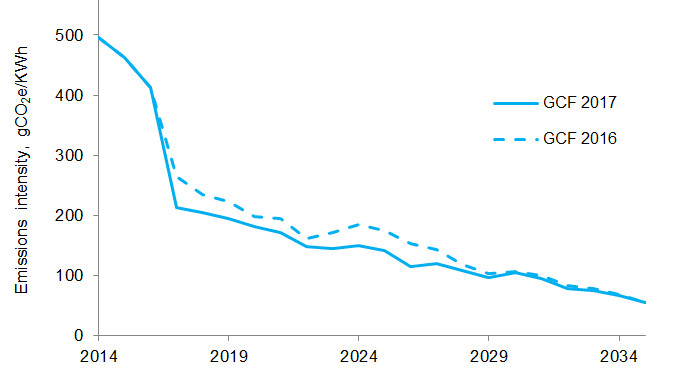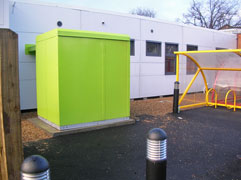
Decarbonising the Grid
The National Grid in the UK is decarbonising rapidly. This permits the electrification of heat and heralds the end to combustion of fossil fuels as the main source of heating. The attractive alternative to combustion is heat transfer using heat pumps linked to ground source energy.
The carbon factor of grid electricity was 495 grams of CO2 for each kWh of electricity generated in 2014 according to Defra. This fell by 6.5% to 462 grams in 2015, and by a further 10.8% to 412 in 2016.
BEIS published its Energy and Emissions Projection (EEP) in January 2018 showing the projected Grid Carbon Factor falling dramatically from 212 grams in 2017 to just 66 grams in 2035. These projections, shown in the graph as a solid blue line, have fallen sharply from the BEIS predictions of a year ago, shown in a dotted blue line.
Decarbonisation of the grid allows electrification of heat, and the most efficient way to use electricity for heating is to employ heat pumps to arrange efficient heat transfer to buildings from the ground.
Electrification of Heat
A typical 100m deep ground source borehole with a single probe in reasonably standard UK geology will support a 5kW heat pump. If this operates for a typical 2,200 run hours a year at an efficiency (SPF) of 3.4 the following carbon reductions would result in the years ahead:
| Heat output kWh | Fuel | System efficiency | Primary energy used kWh | Fuel carbon factor gCO2e/kWh | CO2e emissions kg | Emissions vs natural gas kg |
Emissions vs natural gas |
| 11,000 | Natural gas | 85% | 12,941 | 184 | 2,381 | - | - |
| 11,000 | Electricity | 340% | 3,235 | 494 in 2014 |
1,599 | -782 | -33% |
| 11,000 | Electricity | 340% | 3,235 | 462 in 2015 |
1,495 | -886 | -37% |
| 11,000 | Electricity | 340% | 3,235 | 412 in 2016 |
1,333 | -1,048 | -44% |
| 11,000 | Electricity | 340% | 3,235 | 212 in 2017 |
686 | -1,695 | -71% |
| 11,000 | Electricity | 340% | 3,235 | 205 in 2018 |
663 | -1,718 | -72% |
| 11,000 | Electricity | 340% | 3,235 | 136 est 2020 |
440 | -1,941 | -82% |
| 11,000 | Electricity | 340% | 3,235 | 108 est 2025 |
349 | -2,032 | -85% |
The government has committed to stop burning coal in power stations by 2023 and its projection is that the carbon intensity of the grid will continue to fall to below 150g CO2e/kWh by 2020. When this happens carbon emissions from well installed gshp systems will be dramatically less than carbon emissions from burning natural gas for heating.
Comparisons with more carbon intensive primary fuels such as LPG, oil or direct electrical heating are even more favourable to ground source energy.
It is interesting to note that at a carbon factor of 212g CO2e/kWh, then even direct electric heating emits less carbon than heating by burning natural gas.
In commercial and urban environments where the same ground source borehole infrastructure can deliver cooling in addition to heating, the carbon arguments become even stronger. Where cooling is delivered the ground is charged with heat: when this happens the SPF of heating can improve on the recycling of that heat to increase the SPF to well over 4 and would increase the carbon emission reduction to over 84% based on a carbon factor of 136 by 2020.
CO2 emissions from GSHPs
The GSHP CO2 Emissions Calculator uses current grid carbon intensity, updated every half hour, to illustrate how much lower carbon emissions are now from ground source energy than from burning fossil fuels for other heating systems.
The CO2 issued by a heat pump powered from green electricity is, of course, zero. This CO2 emissions calculator shows the CO2 issued if a ground source heat pump uses grid electricity.
Efficient low carbon heating
It is now possible to chose a very efficient heating system for providing renewable heating, and renewable cooling, with no carbon emissions on site – and rapidly decreasing carbon emissions from the grid.
See Ground Source Heating See Ground Source Cooling See Ground Source Energy

